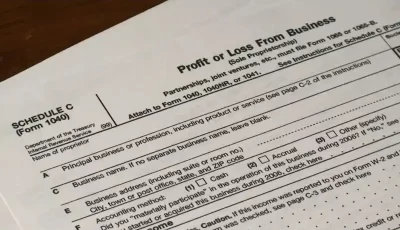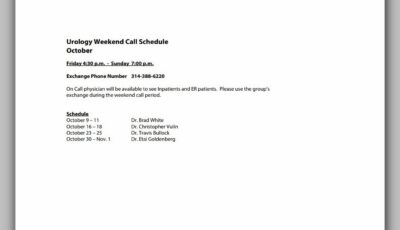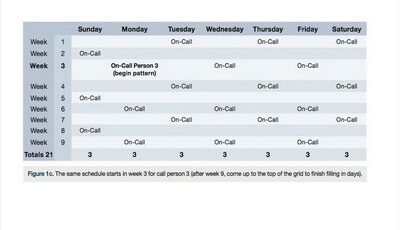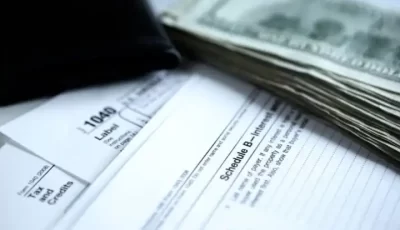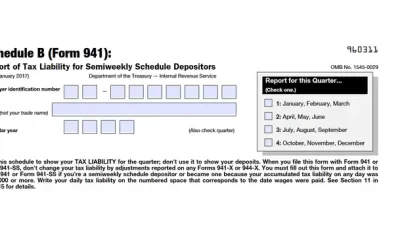Creating a perfect paint schedule can be daunting, but with the right tools and knowledge, it’s easy to get started. This blog post will outline creating a paint schedule based on your specific needs. We recommend reading through the article from start to finish to gain maximum benefit from it. Finally, heed our tips for creating an effective paint schedule as you go!
What is a paint schedule?
A paint schedule is a plan that outlines the days and hours when different types of painting will be done. It can help to improve efficiency and organization within a business.
A properly created paint schedule can save time, money, and hassle by ensuring that all areas of your home are appropriately covered with a layer of protection against weathering and decay.
Furthermore, it can help you avoid potential conflicts between workers who may have conflicting schedules or tasks that must be completed at different times. A well-organized Paint Schedule Template can also improve customer satisfaction as they know what to expect from their contractor or painter during those critical moments when something needs fixing, but no one is around!
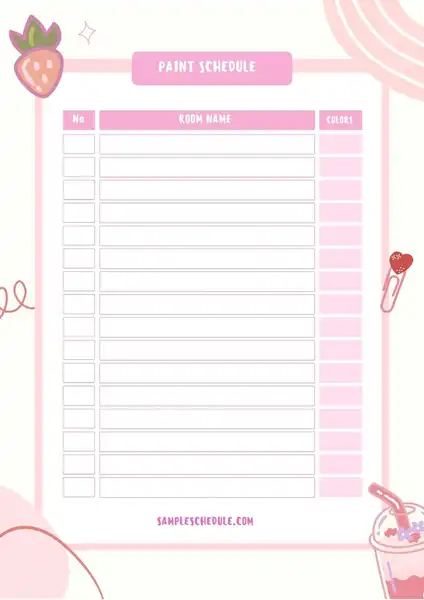
free paint schedule template
house paint tracker
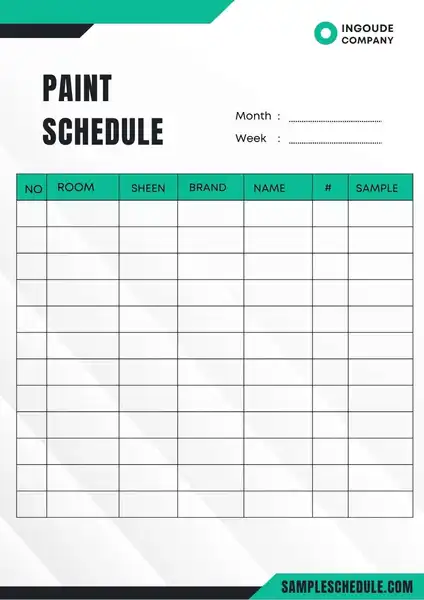
paint schedule
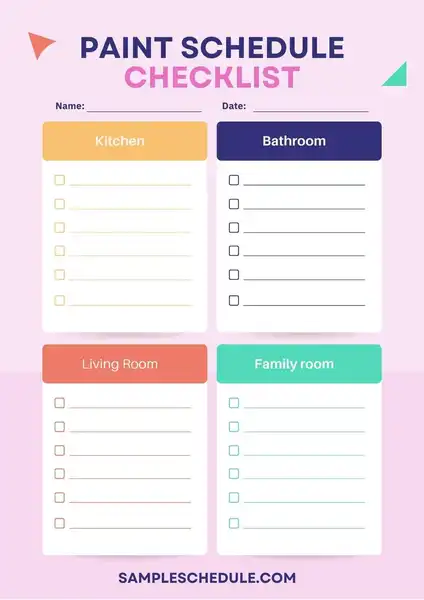
paint schedule checklist
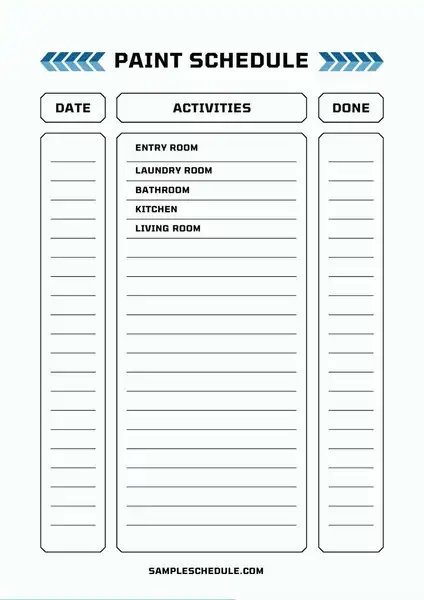
paint schedule example
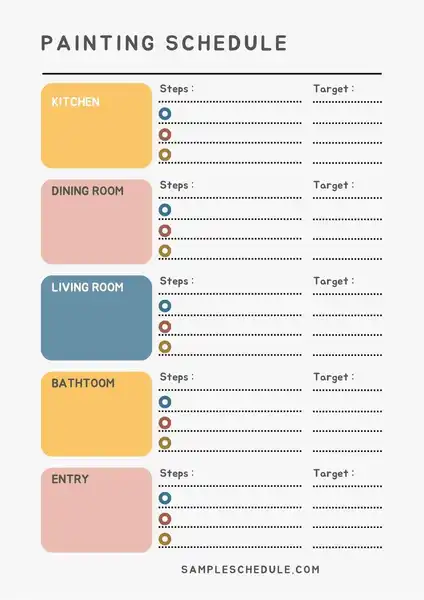
paint schedule template
paint schedule tracker
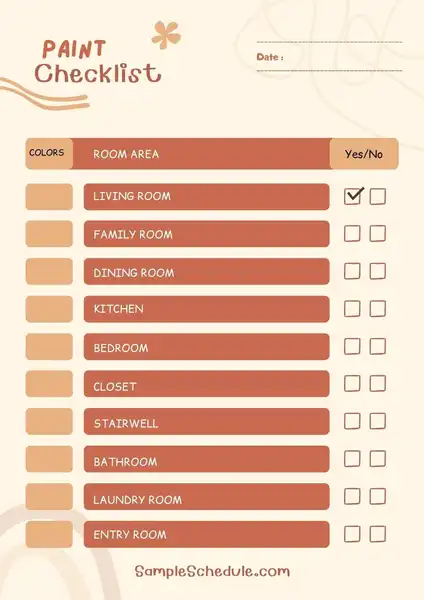
printable paint schedule
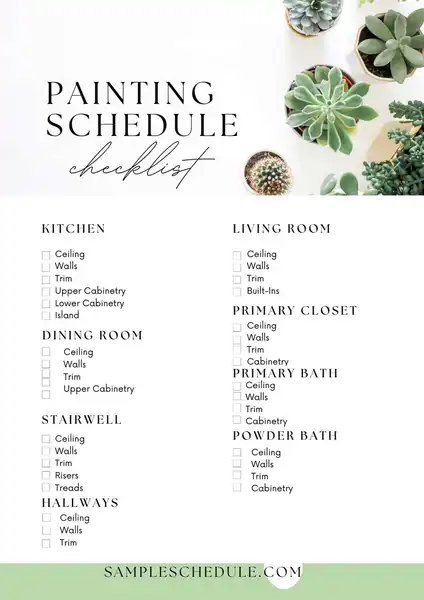
what is paint schedule
Tips for Creating a Paint Schedule
Painting a house is an ambitious undertaking that requires careful planning and execution. Whether you’re doing it yourself or hiring a contractor, there are certain steps you need to take to get the job done right. This article will provide eight tips for creating a paint schedule to ensure your project goes smoothly.
- Determine the scope of the project: Are you painting only one room, or are all of the walls in the house going to be painted? Calculating quantities becomes much easier if you know how much paint and materials are required.
- Choose the right type of paint: Unless otherwise specified by law, always use professional-grade paints when painting any interior surface, such as brickwork or wood surfaces (unless treated). Paints like latex enamels or acrylics can chip if not used properly and could potentially harm your health over time. When in doubt about which type of paint to choose for a particular situation, ask an experienced painter for advice before beginning work
- Determine the timeline: Even with meticulous planning, unexpected delays may arise during construction or weather conditions. Make sure to factor in extra days just in case something comes up – this way, nobody is left unsatisfied at the end!
- Make a list of materials and tools: Before starting any major renovation project, gather all essential supplies, including sponges and brushes.
What needs to be included in a paint schedule?
A paint schedule should include the following information:
- The time and date of the painting
- The types of paints or coatings that will need to be applied
- The type of surface being painted (e.g., wood, metal, drywall)
- When each step in the painting process will take place (e.g., prep work, application, curing/protection)
- Details about how long each stage will last
Different Types of Paint
Painting your home is a big investment, and you want to ensure that the paint you choose will last for years. Here are types of paint and their related properties:
Oil-Based Paint
Oil-based paints are the most affordable and have a low sheen. They are best for interior walls because they don’t reflect light well.
Latex-Based Paint
Latex-based paints have high gloss levels but can be difficult to work with because they require special tools, and temperatures must be maintained carefully to avoid cracking or peeling. They are popular for exterior walls because they resist water, wind, UV rays, and fading.
Specialty Paints
Specialty paints include:
- Metallic paints add an extra layer of protection against weathering.
- Translucent colors allow some light into a room.
- Accent colors can brighten up an area without being too flashy.
These paints are more expensive than other types but may also last longer due to their unique features.
Flat Paint
Flat paint has a matte finish with no shine. It’s a great choice for imperfect walls, as it helps to hide them. However, flat paint is less durable than other finishes and can be difficult to clean.
Eggshell Paint
Eggshell paint has a slightly glossy finish, which makes it a good choice for walls and ceilings that need to be cleaned frequently. It’s also more durable than a flat paint, making it a good choice for areas with a lot of foot traffic.
Semi-Gloss Paint
Semi-gloss paint has a shiny finish that reflects light well. It’s a great choice for areas that need to be cleaned frequently, such as kitchens and bathrooms. However, it can highlight imperfections in the wall, so it’s best to use it on walls in good condition.
Gloss Paint
Gloss paint has a highly reflective, shiny finish that can make walls and surfaces appear smoother. It’s a great choice for trim, doors, and cabinetry, as it is durable and easy to clean. However, it can also highlight imperfections, so it’s important to ensure that the surface is in good condition before using gloss paint.
Read Also: Free Door Schedule Template (Excel, PDF & Web-based)
How do you create a perfect paint schedule?
Creating a perfect paint schedule is about considering as many factors as possible. Here are three key tips to help you get started:
- Start by understanding the type of property that you are painting. Residential properties require different care and preparations than commercial properties, for example. Make sure to adjust your paint schedule accordingly
- Set deadlines and milestones for each stage of the painting process- this will ensure that everything moves along at an efficient pace while still meeting your expectations
- Always be prepared to make changes or adjustments as needed- a painting job is always different, so expecting it to be is unrealistic and can lead to frustration on your part and wasted time and money.
Be aware of the weather conditions when painting.
Paint can be a great way to improve your home’s appearance. However, weather conditions can affect the results of your paint job and how well your paints wear. As such, it is important to be aware of the weather when painting to minimize potential problems.
When you are painting, there are several things that you should keep in mind:
- Weather affects how long it will take to complete a task. For example, if it rains later in the day, expect longer delays due to wet surfaces making everything slick and more difficult for contractors or painters working on site. Likewise, cold temperatures slow down chemical reactions, so be prepared for colder weather may result in less work required overall because coats will dry faster;
- Weather also affects how well paints wear over time-primarily due not only to water but also wind and other outdoor elements, which can cause chipping or peel off of paint layers;
- Finally, pay attention to local forecasts wherever you plan to paint so that you know what conditions might prevail, whether any special preparations (such as applying sealants beforehand) are necessary, etc.
Make sure your equipment is properly calibrated and maintained.
Proper paint equipment calibration and maintenance are critical for a successful painting job. Your results may be consistent, and you could spend more on repairs. Here are five steps to help make sure that happens:
- Calibrate Your Equipment as Often as Necessary
Paint machines work best when calibrated according to manufacturer guidelines or customer preferences. Checking calibration often ensures that the machine is producing accurate color and helps prevent costly repairs in the future. A professional painter should calibrate their equipment at least once per week to achieve consistent results
- Keep All Parts Clean and Tightly Fitted
Proper lubrication between parts can minimize friction and wear, which can cause damage over time (e g., rust or pitted finishes). Make sure all moving parts – such as rollers, brushes, and needles – are cleaned regularly, especially after working with acidic materials like lacquer or enamel paints
- Monitor Pressure Levels Altogether Throughout Application Processes
If one part of the spray gun fails during an application process (such as a nozzle), this failure will propagate throughout the system until pressure levels reach unsafe levels. Proper monitoring allows you to identify potential problems early enough so that corrective action can be taken before any structural damage occurs
- Check for Obstructed Nozzles During Painting Jobs
A blocked nozzle means less paint being delivered where it’s needed
Take your time with your schedule!
Paint scheduling is one of the most important aspects of painting a project. Achieving a perfect paint schedule will ensure that the job progresses smoothly and that all tasks are executed accurately and timely. The following tips will help you create a paint schedule that works best for your project:
- Begin by understanding your timeline. Having realistic expectations when creating your paint schedule is essential, as even slight delays can result in costly extra work or missed deadlines. Consider weather conditions and possible lead times when estimating how long it may take to complete various job stages.
- Ensure each stage is properly aligned with the others; improper sequencing can cause problems down the line, such as damages not being fixed correctly or uneven coats being applied, which could lead to peeling or chipping later in the process.
- Separate non-painting tasks from painting tasks. Try to keep related activities separate, so they do not overlap unnecessarily – this will minimize distractions while working and reduce overall frustration among team members.
- Optimize resources where necessary When assigning specific task responsibilities within your crew, ensure everyone has access to necessary tools and materials, so there are no interruptions during critical moments.
- Plan for contingencies. For projects to run smoothly at any point during their execution, it’s always prudent to anticipate potential hiccups along the way and put measures into place should they occur.
Stick to the plan, even if it seems difficult at first.
Creating a perfect paint schedule can be difficult, but it’s important to stick to the plan. Here are tips for making this process easier:
- Be organized. This is key when creating your painted schedule. Make sure you have all the information you need and that each step of the painting process is well documented. Having a good system will make everything go more smoothly.
- Set realistic deadlines. Putting off tasks until later is tempting, but doing so won’t help. Setting specific dates for when each task should be completed will help keep everyone on track and avoid potential delays or problems down the road.
- Establish priorities. Once you have created your painted schedule, determine which tasks are most important to you and focus on completing those first. This may mean sacrificing some other tasks to get things done faster.
- Take breaks often. Painting isn’t always an easy job, and if you try to do too much at once, it could lead to fatigue or mistakes made during construction (regardless of whether or not you use a painter). Give yourself time daily to relax; this will improve your mood and productivity while painting.
- Use painters who understand your needs. When hiring a painter, remember that their experience doesn’t end with simply having talent in handling colors; they must also understand how best fit into our lifestyle as homeowners/consumers who live within certain geographical.
Conclusion
Thank you for reading! This blog post discusses paint schedules and how they can help your home or business. We also outlined the different needs that should be included in one and tips for creating a perfect plan.
Finally, we mentioned some important weather factors to remember when painting (such as wind protection) and explained why schedules are never a good idea. Read our final tips before getting started on your perfect paint schedule!

